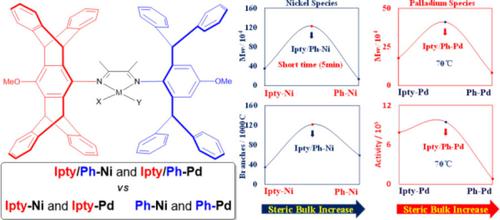当前位置:
X-MOL 学术
›
ChemCatChem
›
论文详情
Our official English website, www.x-mol.net, welcomes your
feedback! (Note: you will need to create a separate account there.)
Unsymmetrical Strategy Makes Significant Differences in α‐Diimine Nickel and Palladium Catalyzed Ethylene (Co)Polymerizations
ChemCatChem ( IF 3.8 ) Pub Date : 2020-03-26 , DOI: 10.1002/cctc.202000141 Xiaoqiang Hu 1, 2 , Yuxing Zhang 1, 2 , Yixin Zhang 1 , Zhongbao Jian 1, 2
ChemCatChem ( IF 3.8 ) Pub Date : 2020-03-26 , DOI: 10.1002/cctc.202000141 Xiaoqiang Hu 1, 2 , Yuxing Zhang 1, 2 , Yixin Zhang 1 , Zhongbao Jian 1, 2
Affiliation

|
Ligand steric bulk is one of the most important parameters on determining activity, polymer molecular weight, and branching density in α‐diimine Ni(II) and Pd(II) catalyzed ethylene polymerization. In this contribution, we delineated an unsymmetrical strategy to shed light on the effect of steric bulk in α‐diimine species via the unsymmetrically pentiptycenyl/dibenzhydryl α‐diimine Ni(II) and Pd(II) catalysts Ipty/Ph‐Ni and Ipty/Ph‐Pd versus symmetrical pentiptycenyl analogues Ipty‐Ni and Ipty‐Pd and symmetrical dibenzhydryl analogues Ph‐Ni and Ph‐Pd. In the Ni(II) catalyzed ethylene polymerization, new features have been revealed: (1) with the increase of steric bulk (Ph‐Ni > Ipty/Ph‐Ni > Ipty‐Ni), in a relatively long 30 min polymer molecular weights increase, yet Ipty/Ph‐Ni produces the highest molecular weight (1230 kDa) in a short 5 min; (2) with increasing steric bulk, branching density first rises and then falls, liking a downward parabola. In the Pd(II) catalyzed ethylene polymerization, increasing steric bulk enhanced activity and molecular weight or not, dependent on temperature, but usually decreased branching density. Consequently, Ipty/Ph‐Pd gave the highest activity and the highest molecular weight (412 kDa) at challenging high temperature of 70 °C. Plausible insights have been given to address these differences from previous results. Notably, unsymmetrical Ni(II) and Pd(II) catalysts also enabled copolymerizations of ethylene with various polar comonomers.
中文翻译:

不对称策略在α-二胺镍和钯催化的乙烯(Co)聚合反应中产生了重大差异
配体空间体积是决定α-二亚胺Ni(II)和Pd(II)催化的乙烯聚合反应的活性,聚合物分子量和支化密度的最重要参数之一。在这项贡献中,我们描述了一种不对称策略,以通过不对称的戊烯基/二苯甲酰基α-二亚胺Ni(II)和Pd(II)催化剂Ipty / Ph-Ni和Ipty / Ph‐Pd与对称的戊基烯基类似物Ipty‐Ni和Ipty‐Pd以及对称的二苯甲酰基类似物Ph‐Ni和Ph‐Pd。在Ni(II)催化的乙烯聚合反应中,发现了新的特征:(1)随着空间体积的增加(Ph-Ni > Ipty / Ph-Ni > Ipty-Ni),在相对长的30分钟内聚合物分子量增加,而Ipty / Ph-Ni在短短的5分钟内产生最高分子量(1230 kDa);(2)随着空间体积的增加,分支密度先上升然后下降,就像一个向下的抛物线。在Pd(II)催化的乙烯聚合反应中,增加空间位阻会提高活性和分子量(取决于温度),或不取决于温度,但通常会降低支化密度。因此,Ipty / Ph-Pd在挑战性的70°C高温下具有最高的活性和最高的分子量(412 kDa)。已经给出了合理的见解来解决与先前结果的这些差异。值得注意的是,不对称的Ni(II)和Pd(II)催化剂还能够使乙烯与各种极性共聚单体共聚。
更新日期:2020-03-26
中文翻译:

不对称策略在α-二胺镍和钯催化的乙烯(Co)聚合反应中产生了重大差异
配体空间体积是决定α-二亚胺Ni(II)和Pd(II)催化的乙烯聚合反应的活性,聚合物分子量和支化密度的最重要参数之一。在这项贡献中,我们描述了一种不对称策略,以通过不对称的戊烯基/二苯甲酰基α-二亚胺Ni(II)和Pd(II)催化剂Ipty / Ph-Ni和Ipty / Ph‐Pd与对称的戊基烯基类似物Ipty‐Ni和Ipty‐Pd以及对称的二苯甲酰基类似物Ph‐Ni和Ph‐Pd。在Ni(II)催化的乙烯聚合反应中,发现了新的特征:(1)随着空间体积的增加(Ph-Ni > Ipty / Ph-Ni > Ipty-Ni),在相对长的30分钟内聚合物分子量增加,而Ipty / Ph-Ni在短短的5分钟内产生最高分子量(1230 kDa);(2)随着空间体积的增加,分支密度先上升然后下降,就像一个向下的抛物线。在Pd(II)催化的乙烯聚合反应中,增加空间位阻会提高活性和分子量(取决于温度),或不取决于温度,但通常会降低支化密度。因此,Ipty / Ph-Pd在挑战性的70°C高温下具有最高的活性和最高的分子量(412 kDa)。已经给出了合理的见解来解决与先前结果的这些差异。值得注意的是,不对称的Ni(II)和Pd(II)催化剂还能够使乙烯与各种极性共聚单体共聚。











































 京公网安备 11010802027423号
京公网安备 11010802027423号